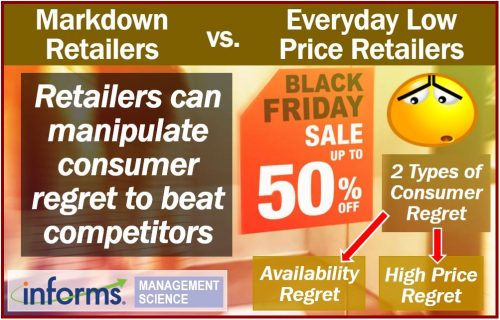Retailers can manipulate consumer regret to beat rivals, say researchers. Markdown retailers can survive the entry of an everyday low price retailer into a highly competitive market by manipulating price. They can also survive by manipulating product availability and consumer regret. Specifically, the regret shoppers feel when they overpaid or waited till a product sold out and became unavailable.
The findings of a recent study explain why markdown pricing is still so common. That is, still ubiquitous despite the simplicity and operational and marketing benefits of everyday low pricing.
Retail pricing types
There are two main types of retail pricing, markdown pricing and everyday low price.
Markdown pricing
With markdown pricing, sellers offer an item at one price early in the season. Later on in the season, however, they offer it at a discounted price.
Everyday low price
With everyday low price, on the other hand, as the name indicates, sellers offer their products at the same price. In other words, there are no markdowns at the end of the season.

Defending against a new competitor
Elodie Adida Goodman and Özalp Özer wrote about their study and findings in the journal Management Science (citation below).
Goodman is an Associate Professor of Operations and Supply Chain Management at the University of California, Riverside’s School of Business. Özer is a Professor of Management Science at the University of Texas at Dallas’ Jindal School of Management.
The authors wondered whether retailers could use either of the two pricing strategies to defend against a newcomer in the marketplace. In this context, the word ‘marketplace‘ means the same as ‘market‘ in its abstract sense.
Consumer regret
The researchers designed a model that assigned values to pricing strategies, retail outcomes, and also consumer regret.
If you buy something at the beginning of the season and subsequently see it at a lower price later on, you may experience ‘high price regret.’ High price regret is a kind of consumer regret.
Deciding to buy later when prices are lower, on the other hand, can be a risky option. If the item sells out before the seller introduces a discount, you may experience ‘availability regret.’ In other words, you wish you had purchased it earlier before it became unavailable. Availability regret is also a type of consumer regret.

Manipulating both types of consumer regret
Markdown retailers
The modeling showed that markdown retailers could manipulate both types of consumer regret to boost sales. Specifically, to boost sales at both the original and sale prices. They did this by carefully controlling the supply and price of the product.
Everyday low price retailers
Everyday low price retailers could only manipulate one type of consumer regret – high price regret – by controlling their price.
However, sometimes even this pricing strategy did not work. Consumers who had bought from the everyday low price retailer could still suffer from high price regret during seasonal sales at markdown retailers. This was especially the case if the markdown seller’s sale price was lower than the everyday low price retailer’s.
Everyday low price retailers failed in competition with markdown retailer newcomers. Even the incumbent everyday low price retailers, i.e., those that had been selling in the marketplace for a long time, failed.
Beware of switching pricing strategies
In a press release, UC Riverside wrote:
“The results help explain why switching from a markdown pricing mode to everyday low pricing mode can have disastrous results for retailers like JC Penney, whose dismal everyday low price experiment has become a marketing cautionary tale.”
Regarding pricing strategies for newcomers and incumbents, Prof. Goodman said:
“For a retailer facing the risk of competitors entering the market, the markdown pricing mode will be more successful than everyday low price.”
“Existing retailers with a markdown pricing mode will be more likely to survive when competitor enters the market than if they use an everyday low price pricing mode.”
“For a new retailer trying to break into a market employing markdown pricing, everyday low price strategy might be effective.”
The term ‘buyer’s remorse‘ has the same meaning as ‘consumer regret.’

